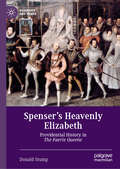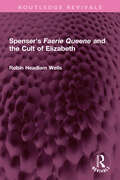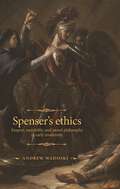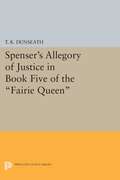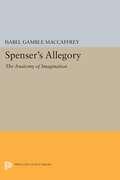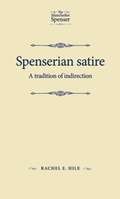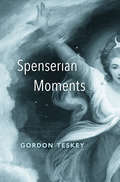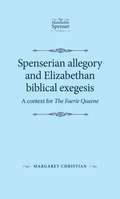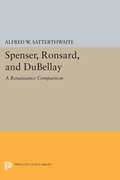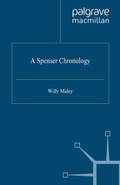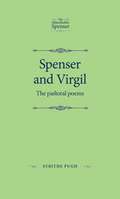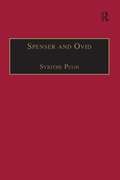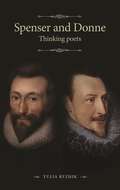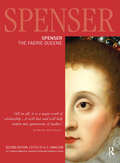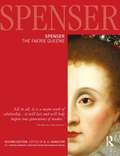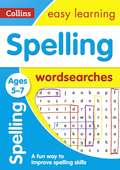- Table View
- List View
Spenser’s Heavenly Elizabeth: Providential History in The Faerie Queene (Queenship and Power)
by Donald StumpThis book reveals the queen behind Edmund Spenser’s The Faerie Queene. Placing Spenser’s epic poem in the context of the tumultuous sixteenth century, Donald Stump offers a groundbreaking reading of the poem as an allegory of Elizabeth I’s life. By narrating the loves and wars of an Arthurian realm that mirrors Elizabethan England, Spenser explores the crises that shaped Elizabeth’s reign: her break with the pope to create a reformed English Church, her standoff with Mary, Queen of Scots, offensives against Irish rebels and Spanish troops, confrontations with assassins and foreign invaders, and the apocalyptic expectations of the English people in a time of national transformation. Brilliantly reconciling moral and historicist readings, this volume offers a major new interpretation of The Faerie Queene.
Spenser's Faerie Queene and the Cult of Elizabeth (Routledge Revivals)
by Robin Headlam WellsFirst published in 1983, Spenser’s Faerie Queene and the Cult of Elizabeth presents The Faerie Queene as a central document in the cult of Elizabeth. It shows how Spenser combines the resources of medieval iconography and Renaissance rhetoric in celebrating the Queen as the predestined ruler of an elect nation. In its introductory discussion of Renaissance poetics, the book emphasises the contemporary belief in the moral function of praise. Particular attention is given to the popular identification of Elizabeth with the Virgin Mary. If Elizabeth’s gender created problems for a poet writing in the heroic mode, at the same time it made available to him a form of praise that no secular poet had been able to use before. While the book contains material of interest to the Renaissance specialist, its lucid style and the valuable background material it provides will appeal to undergraduates reading Spenser for the first time.
Spenser's Faerie Queene and the Cult of Elizabeth (Routledge Revivals)
by Robin Headlam WellsFirst published in 1983, Spenser’s Faerie Queene and the Cult of Elizabeth presents The Faerie Queene as a central document in the cult of Elizabeth. It shows how Spenser combines the resources of medieval iconography and Renaissance rhetoric in celebrating the Queen as the predestined ruler of an elect nation. In its introductory discussion of Renaissance poetics, the book emphasises the contemporary belief in the moral function of praise. Particular attention is given to the popular identification of Elizabeth with the Virgin Mary. If Elizabeth’s gender created problems for a poet writing in the heroic mode, at the same time it made available to him a form of praise that no secular poet had been able to use before. While the book contains material of interest to the Renaissance specialist, its lucid style and the valuable background material it provides will appeal to undergraduates reading Spenser for the first time.
Spenser's ethics: Empire, mutability, and moral philosophy in early modernity (The Manchester Spenser)
by Andrew WadoskiSpenser’s ethics offers a novel account of Edmund Spenser as a moral theorist, situating his ethics at the nexus of moral philosophy’s profound transformation in the early modern era, and the English colonisation of Ireland in the turbulent 1580’s and 90’s. It revises a scholarly narrative describing Spenser’s ethical thinking as derivative, nostalgic, or inconsistent with one that contends him to be one of early modern England’s most original and incisive moral theorists, placing The Faerie Queene at the centre of the contested discipline of moral philosophy as it engaged the social, political, and intellectual upheavals driving classical virtue ethics’ unravelling at the threshold of early modernity.
Spenser's ethics: Empire, mutability, and moral philosophy in early modernity (The Manchester Spenser)
by Andrew WadoskiSpenser’s ethics offers a novel account of Edmund Spenser as a moral theorist, situating his ethics at the nexus of moral philosophy’s profound transformation in the early modern era, and the English colonisation of Ireland in the turbulent 1580’s and 90’s. It revises a scholarly narrative describing Spenser’s ethical thinking as derivative, nostalgic, or inconsistent with one that contends him to be one of early modern England’s most original and incisive moral theorists, placing The Faerie Queene at the centre of the contested discipline of moral philosophy as it engaged the social, political, and intellectual upheavals driving classical virtue ethics’ unravelling at the threshold of early modernity.
Spenser's Allegory of Justice in Book Five of the Fairie Queen
by T. K. Dunseath"The importance of Dunseath's study is that it proposes an original interpretation of the allegory of The Faerie Queene, Book V, and a fresh theory of its poetic function.... It brings new material into play, and offers a sensible, integrated reading of many of the poem’s most important passages, so that it may well prove a pace-setter for this kind of Spenserian study."—Alastair Fowler, Brasenose College, Oxford.Originally published in 1968.The Princeton Legacy Library uses the latest print-on-demand technology to again make available previously out-of-print books from the distinguished backlist of Princeton University Press. These editions preserve the original texts of these important books while presenting them in durable paperback and hardcover editions. The goal of the Princeton Legacy Library is to vastly increase access to the rich scholarly heritage found in the thousands of books published by Princeton University Press since its founding in 1905.
Spenser's Allegory: The Anatomy of Imagination
by Isabel Gamble MaccaffreyIsabel MacCaffrey contends that, in allegory, the mind makes a model of itself, and she shows that The Faerie Queene, mirroring as it does the mind's structure, is both a treatise on and an example of the central role that imagination plays in human life.Viewing the poem as a model of Spenser's universe, the author investigates the poet's theory of knowledge and the role of imagination in the construction of cosmic models. She begins with a survey of theories of the imagination and the creation of fictions, establishing a context in which allegorical images may be understood throughout the European allegorical tradition to which The Faerie Queene belongs. Isabel MacCaffrey's new readings show that insofar as Spenser's poem concerns modes of knowledge, it offers the reader an anatomy of its own composition, an analysis of imagination in its varied relations to the world.Originally published in 1976.The Princeton Legacy Library uses the latest print-on-demand technology to again make available previously out-of-print books from the distinguished backlist of Princeton University Press. These editions preserve the original texts of these important books while presenting them in durable paperback and hardcover editions. The goal of the Princeton Legacy Library is to vastly increase access to the rich scholarly heritage found in the thousands of books published by Princeton University Press since its founding in 1905.
Spenserian satire: A tradition of indirection (PDF)
by Rachel E. HileA detailed study of Spenser's poetic legacy, focusing on his reputation as a satirist and his influence on satirical poetry written by his contemporaries.
Spenserian satire: A tradition of indirection
by Rachel E. HileA detailed study of Spenser's poetic legacy, focusing on his reputation as a satirist and his influence on satirical poetry written by his contemporaries.
Spenserian Moments
by Gordon TeskeyGordon Teskey restores Edmund Spenser to prominence, revealing his epic The Faerie Queene as a grand, improvisatory project on human nature. Teskey compares Spenser to Milton, an avowed follower. While Milton’s rigid ideology is now stale, Spenser’s allegories remain vital, inviting new questions and visions, heralding a constantly changing future.
Spenserian allegory and Elizabethan biblical exegesis: A context for The Faerie Queene (PDF) (The Manchester Spenser)
by Margaret ChristianCritical analysis of the importance and influence of Elizabethan biblical typology on Spenser and the composition of the Faerie Queene.
Spenserian allegory and Elizabethan biblical exegesis: A context for The Faerie Queene (The Manchester Spenser)
by Margaret ChristianCritical analysis of the importance and influence of Elizabethan biblical typology on Spenser and the composition of the Faerie Queene.
Spenser, Ronsard, and DuBellay
by Alfred W. SatterthwaiteAlthough it has been recognized that Edmund Spenser's poetry owes a debt to the work of the French poets of the Pléiade, particularly to Joachim du Bellay and Pierre de Ronsard, there has been no critical analysis of this relationship. Mr. Satterthwaite compares the work of the three poets, showing the relation between the English movement to write quantitative verse and the French experiments in vers mesures. He discusses the attitudes of the poets to their Muses and to contemporary literature, their ideas of time and mutability, their moral (or amoral) views of literature and of life their religious orientation, and their use of the Platonic and neo-Platonic theories that were a part of the inherited culture of the Renaissance.Originally published in 1960.The Princeton Legacy Library uses the latest print-on-demand technology to again make available previously out-of-print books from the distinguished backlist of Princeton University Press. These editions preserve the original texts of these important books while presenting them in durable paperback and hardcover editions. The goal of the Princeton Legacy Library is to vastly increase access to the rich scholarly heritage found in the thousands of books published by Princeton University Press since its founding in 1905.
A Spenser Chronology: Spenser Chronology (Author Chronologies Series)
by W. Maley`...a valuable and welcome book; it belongs in any library that has pretensions of supporting Spenser scholarship.' - Russel J. Meyer, Spenser Newsletter A Spenser Chronology is the first serious attempt to map out in concrete detail all of the known facts concerning the poet Edmund Spenser, a major canonical author whose entire literary career was spent in Ireland. This book charts Spenser's parallel vocations of Elizabethan planter and Renaissance writer, outlining the activities, appointments and whereabouts of a prominent Irish colonist, and shedding new light on the life of one of the most important figures in English literary history.
Spenser and Virgil: The pastoral poems (PDF) (The Manchester Spenser)
by Syrithe PughAn engaging study that offers new and provocative re-readings of Spenser's pastoral poems, with a focus on Spenser's acknowledged debt to Virgil and his Eclogues. Reception studies, politics and classical studies are interweaved to provide a greater understanding of both poets.
Spenser and Virgil: The pastoral poems (The Manchester Spenser)
by Syrithe PughAn engaging study that offers new and provocative re-readings of Spenser's pastoral poems, with a focus on Spenser's acknowledged debt to Virgil and his Eclogues. Reception studies, politics and classical studies are interweaved to provide a greater understanding of both poets.
Spenser and Ovid
by Syrithe PughIn Spenser and Ovid, Syrithe Pugh gives the first sustained account of Ovid's presence in the Spenser canon, uncovering new evidence to reveal the thematic and formal debts many of Spenser's poems owe to Ovid, particularly when considered in the light of an informed understanding of all of Ovid's work. Pugh's reading presents a challenge to New Historicist assumptions, as she contests both the traditional insistence on Virgil as Spenser's prime classical model and the idea it has perpetuated of Spenser as Elizabeth I's imperial propagandist. In fact, Pugh locates Ovid's importance to Spenser precisely in his counter-Virgilian world view, with its high valuation of faithful love, concern for individual freedom, distrust of imperial rule, and the poet's claim to vatic authority in opposition to political power. Her study spans Spenser's career from the inaugural Shepheardes Calender to what was probably his last poem, The Mutabilitie Cantos, and embraces his work in the genres of pastoral, love poetry, and epic romance.
Spenser and Ovid
by Syrithe PughIn Spenser and Ovid, Syrithe Pugh gives the first sustained account of Ovid's presence in the Spenser canon, uncovering new evidence to reveal the thematic and formal debts many of Spenser's poems owe to Ovid, particularly when considered in the light of an informed understanding of all of Ovid's work. Pugh's reading presents a challenge to New Historicist assumptions, as she contests both the traditional insistence on Virgil as Spenser's prime classical model and the idea it has perpetuated of Spenser as Elizabeth I's imperial propagandist. In fact, Pugh locates Ovid's importance to Spenser precisely in his counter-Virgilian world view, with its high valuation of faithful love, concern for individual freedom, distrust of imperial rule, and the poet's claim to vatic authority in opposition to political power. Her study spans Spenser's career from the inaugural Shepheardes Calender to what was probably his last poem, The Mutabilitie Cantos, and embraces his work in the genres of pastoral, love poetry, and epic romance.
Spenser and Donne: Thinking poets
by Richard Danson Brown Christopher Dean Johnson Niranjan Goswami Kathryn Walls Patrick Cheney Anne Lake Prescott Elizabeth Harvey Ramie Targoff Linda Gregerson Ayesha Ramachandran David Marno Jane Grogan Anne FogartyThe names Edmund Spenser and John Donne are typically associated with different ages in English poetry, the former with the sixteenth century and the Elizabethan Golden Age, the latter with the ‘metaphysical’ poets of the seventeenth century. This collection of essays, part of The Manchester Spenser series, brings together leading Spenser and Donne scholars to challenge this dichotomous view and to engage critically with both poets, not only at the sites of direct allusion, imitation, or parody, but also in terms of common preoccupations and continuities of thought, informed by the literary and historical contexts of the politically and intellectually turbulent turn of the century. Juxtaposing these two poets, so apparently unlike one another, for comparison rather than contrast changes our understanding of each poet individually and moves towards a more holistic, relational view of their poetics.
Spenser and Donne: Thinking poets (The Manchester Spenser)
by Yulia RyzhikThis edited collection of essays, part of The Manchester Spenser series, brings together leading Spenser and Donne scholars to challenge the traditionally dichotomous view of these two major poets and to shift the critical conversation towards a more holistic, relational view of the two authors’ poetics and thought.
Spenser: The Faerie Queene
by A. C. HamiltonThe Faerie Queene is a scholarly masterpiece that has influenced, inspired, and challenged generations of writers, readers and scholars since its completion in 1596. Hamilton's edition is itself, a masterpiece of scholarship and close reading. It is now the standard edition for all readers of Spenser. The entire work is revised, and the text of The Faerie Queene itself has been freshly edited, the first such edition since the 1930s. This volume also contains additional original material, including a letter to Raleigh, commendatory verses and dedicatory sonnets, chronology of Spenser's life and works and provides a compilation of list of characters and their appearances in The Faerie Queene.
Spenser: The Faerie Queene
by A. C. HamiltonThe Faerie Queene is a scholarly masterpiece that has influenced, inspired, and challenged generations of writers, readers and scholars since its completion in 1596. Hamilton's edition is itself, a masterpiece of scholarship and close reading. It is now the standard edition for all readers of Spenser. The entire work is revised, and the text of The Faerie Queene itself has been freshly edited, the first such edition since the 1930s. This volume also contains additional original material, including a letter to Raleigh, commendatory verses and dedicatory sonnets, chronology of Spenser's life and works and provides a compilation of list of characters and their appearances in The Faerie Queene.
Spelltrack Workbook: Spelling Activities for Key Stages 1 and 2
by Laura CryerSpelltrack is a practical approach to spelling, developed to help children who have specific difficulties with phoneme awareness, segmenting, blending and phoneme-letter correspondences. It helps to maintain a systematic progression through the process of learning to read and spell. This book presents activities using tracking techniques to help those learners who have particular difficulty in memorizing high frequency words. By circling (tracking) each letter in one continuous movement, at the same time as saying the letter name, the learner is using visual and kinesthetic senses as well as learning the phonic components of the word. Writing out the spelling from memory, saying the letter names or mnemonic as he or she does so, provides reinforcement of correct letter formation and good handwriting. The workbook focuses on helping children to learn 'tricky' words that are not phonically regular. Words in common everyday sequences have been included too, to give learners confidence with these words as quickly as possible. Using Spelltrack activities can help children to scan a line of type effectively, improving reading, letter recognition and discrimination skills; correct problems of left-to-right directionality, omissions and reversals; improve visual recognition, matching and selecting; improve graphic knowledge and phoneme/graphic correspondence; work on fine motor control; consolidate phonic skills and early spelling strategies; and learn proofreading skills.
Spelltrack Workbook: Spelling Activities for Key Stages 1 and 2
by Laura CryerSpelltrack is a practical approach to spelling, developed to help children who have specific difficulties with phoneme awareness, segmenting, blending and phoneme-letter correspondences. It helps to maintain a systematic progression through the process of learning to read and spell. This book presents activities using tracking techniques to help those learners who have particular difficulty in memorizing high frequency words. By circling (tracking) each letter in one continuous movement, at the same time as saying the letter name, the learner is using visual and kinesthetic senses as well as learning the phonic components of the word. Writing out the spelling from memory, saying the letter names or mnemonic as he or she does so, provides reinforcement of correct letter formation and good handwriting. The workbook focuses on helping children to learn 'tricky' words that are not phonically regular. Words in common everyday sequences have been included too, to give learners confidence with these words as quickly as possible. Using Spelltrack activities can help children to scan a line of type effectively, improving reading, letter recognition and discrimination skills; correct problems of left-to-right directionality, omissions and reversals; improve visual recognition, matching and selecting; improve graphic knowledge and phoneme/graphic correspondence; work on fine motor control; consolidate phonic skills and early spelling strategies; and learn proofreading skills.
Spelling Word Searches Ages 5-7 (Collins Easy Learning KS1 Ser.)
by Collins Easy Collins Easy LearningLevel: KS1 Subject: English Children will have lots of fun practising their spelling using these word searches. Written to match the new primary curriculum, each word search ensures that your child covers the key word lists required at school.
